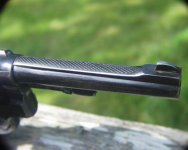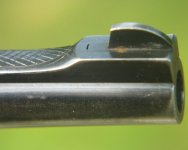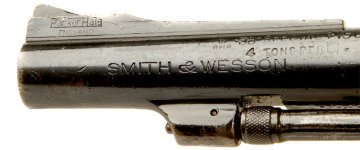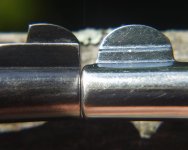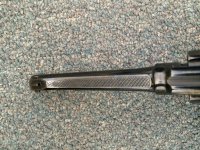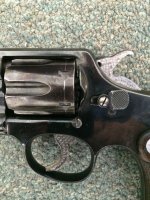Nicksterdemus
Member
Since it found it's way on top of a Victory .38 S&W I think this forum would be the best. I haven't the foggiest notion where it came from or when though I suspect it to be at least fifty years of age.
It's four inches in length though it well could've been a bit longer. Perhaps up to five inches. It's a raised rib w/flat base, 21x 8.5x6mm", that surrounds the front sight. The front sight that came w/Barrel.
Yet, upon sloping the remainder three inches are domed on top w/hand checked engraving whilst sides taper from 3-1mm. Width of engraving 7mm overall rib width 10mm.
Since this is on a .38 S&W I speculate that the rib may be from across the pond. Plus the measurements work out almost entirely to even mm.
The inside of the rib is brass and that is sheathed by thin plate on at least three sides. It appears from the front that the original front side base of the barrel has been cut. Leaving only a thin blade sight that's been notched in the rear.
The front of the rib is notched in the middle, 18x2mm, allowing it to fit tightly against the existing blade on the barrel. Look as a tuning fork before assembly.
It's somewhat ingenious and simplistic in design. The two sides of front sight base had to be removed leaving only the thin blade, but then though requiring some means of mounting securely, it merely slipped on sight/barrel.
My '46 6" HE 38 spl barrel front site/base measures the same. Although the lopped off/no muzzle .38 S&W barrel is noticeably thicker.
It seems plausible that just the front sides of the base could have been notched just a bit. Exposing the sight blade all the way to the barrel. If this the case then the barrel rib base would then fit over the rest, as a cap, w/o completely removing the sides. Granted that would probably require design specifically for S&W models.
At the top where the barrel goes there is some metal relief. The installer then cut the rib exposing brass allowing it to taper into the relief. This secures the back of the rib. He left a notch perhaps by scratch awl on the right side lining up the rib to fit squarely. I guess. It's possible the front is a pressed fit.
It isn't a professional installation job, yet they did exhibit quite a bit of skill at moments. They had to cut the thin sheath of metal off the back end to expose the brass and then take some of that down to fit into the relief cut into the frame.
This is noticeable w/o loupe, but one is needed to see the thin metal sheath. Bear in mind that the size of the the rib width in the first pic is larger than the actual width of the cylinder. I'm surprised no one has taken a Sharpie to the revealed brass. It would blend well to the naked eye.
I think it's an interesting piece of work. I'm not sure why the muzzle was cut smooth matching the end of the rib base.
I welcome any speculation. Perchance the pics will jog a memory.
It's four inches in length though it well could've been a bit longer. Perhaps up to five inches. It's a raised rib w/flat base, 21x 8.5x6mm", that surrounds the front sight. The front sight that came w/Barrel.
Yet, upon sloping the remainder three inches are domed on top w/hand checked engraving whilst sides taper from 3-1mm. Width of engraving 7mm overall rib width 10mm.
Since this is on a .38 S&W I speculate that the rib may be from across the pond. Plus the measurements work out almost entirely to even mm.
The inside of the rib is brass and that is sheathed by thin plate on at least three sides. It appears from the front that the original front side base of the barrel has been cut. Leaving only a thin blade sight that's been notched in the rear.
The front of the rib is notched in the middle, 18x2mm, allowing it to fit tightly against the existing blade on the barrel. Look as a tuning fork before assembly.
It's somewhat ingenious and simplistic in design. The two sides of front sight base had to be removed leaving only the thin blade, but then though requiring some means of mounting securely, it merely slipped on sight/barrel.
My '46 6" HE 38 spl barrel front site/base measures the same. Although the lopped off/no muzzle .38 S&W barrel is noticeably thicker.
It seems plausible that just the front sides of the base could have been notched just a bit. Exposing the sight blade all the way to the barrel. If this the case then the barrel rib base would then fit over the rest, as a cap, w/o completely removing the sides. Granted that would probably require design specifically for S&W models.
At the top where the barrel goes there is some metal relief. The installer then cut the rib exposing brass allowing it to taper into the relief. This secures the back of the rib. He left a notch perhaps by scratch awl on the right side lining up the rib to fit squarely. I guess. It's possible the front is a pressed fit.
It isn't a professional installation job, yet they did exhibit quite a bit of skill at moments. They had to cut the thin sheath of metal off the back end to expose the brass and then take some of that down to fit into the relief cut into the frame.
This is noticeable w/o loupe, but one is needed to see the thin metal sheath. Bear in mind that the size of the the rib width in the first pic is larger than the actual width of the cylinder. I'm surprised no one has taken a Sharpie to the revealed brass. It would blend well to the naked eye.
I think it's an interesting piece of work. I'm not sure why the muzzle was cut smooth matching the end of the rib base.
I welcome any speculation. Perchance the pics will jog a memory.
Attachments
Last edited:


